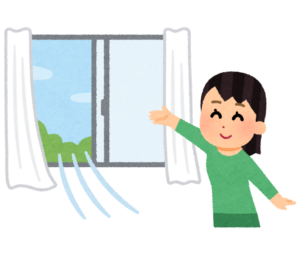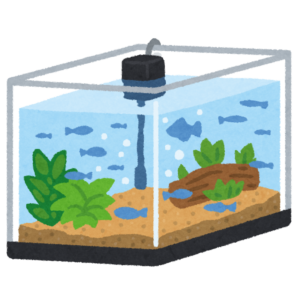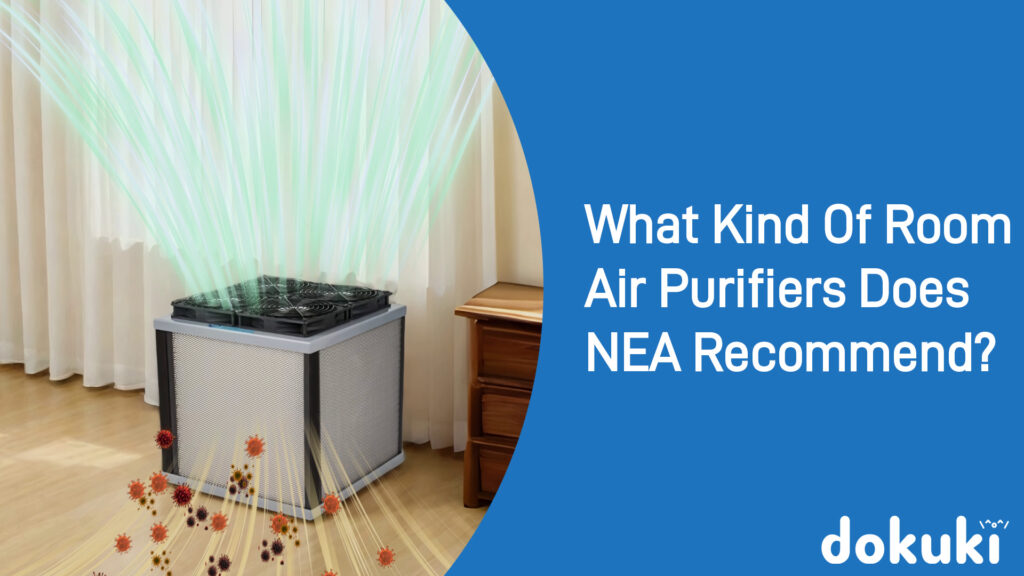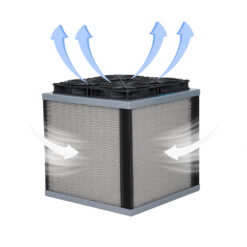In 2021, the Singapore NEA (National Environment Agency) published a set of recommendations on the sizing of room air purifiers to ensure that your home is getting sufficient clean air, otherwise the air you are breathing in may not be as clean as you think.
In this article, we will take a closer look at the recommendations and learn how to calculate and check if your room air purifiers are powerful enough to meet them.
What does the NEA recommend?

The Singapore NEA recommends having at least 5 to 7 air changes per hour (ACH) of clean air in each room. This means that any kind of room air purifier that relies on air filtration through mechanical means (fan and filter) is fine, as long as it is powerful enough to meet or exceed the number of air changes recommended.
Air changes per hour refers to the number of times the volume of air in a room is cleaned, whether through air filtration or other means.
It has also recommended to avoid electronic air purifiers that could potentially generate ozone, such as ionizers, ozone air purifiers, “negatively-charged ion technology”, or “plasma technology.” Ozone is a pollutant and long-term exposure could lead to health problems such as aggravation of asthma and chest pain.
Air purifiers that rely on mechanical means, aka a fan and filter, have been used for decades, are rigorously tested, and do not pose health risks to humans and animals.
Why is NEA’s recommendation important?

Without knowing how many air changes per hour a room air purifier is delivering, you won’t be able to tell whether the air purifier is delivering enough clean air in a room.
Using an under-powered room air purifier with a low Clean Air Delivery Rate (CADR) in a large living room is akin to using a tiny motor to clean a large aquarium. Fish tanks typically require 4 to 10 water changes per hour. Anything less than that could lead to the fish falling sick or even dying due to the spread of diseases and water pollution.
The same applies to humans and animals living in an indoor space – less clean air means more pollutants, resulting in allergy symptoms, spread of airborne diseases such as COVID-19, and other detrimental health effects.
Learn more about the importance of air changes per hour here.
How to calculate air changes per hour?
In order to calculate air changes per hour, you will need:
- Clean Air Delivery Rate (CADR) of the room air purifier
- Total volume of the room (room length x room width x room height)
You should aim for a high ACH number – the higher, the cleaner the air. A high ACH number indicates that the room’s air is cleaned at a faster rate than one that is low.
ACH can be calculated by using the formula below. Alternatively, you can use our handy Air Changes Calculator, which can help you calculate quickly and easily.
Clean Air Delivery Rate (m³/h) / ( Room Area (m²) x Room Height (m) ) = Air Changes per Hour
Using the formula above, we can compare the performance of multiple room air purifiers at their highest CADR, assuming:
- The room is 15 m² (standard bedroom size in Singapore)
- The floor-to-ceiling height is 2.6 m (standard floor-to-ceiling height in HDB flats)
Product 1 – AirFanta 3Pro (S$195)
702 m³/h / ( 15 m² x 2.6 m ) = 18 ACH
Result: 18 air changes per hour (exceeds NEA’s recommendation by 3 times)
Product 2 – Novita Air Purifier A5 (S$328)
273 m³/h / ( 15 m² x 2.6 m ) = 7 ACH
Result: 7 air changes per hour (meets NEA recommendation)
Product 3 – Levoit Core Mini Air Purifier (S$155.90)
58 m³/h / ( 15 m² x 2.6 m ) = 1.81 ACH
Result: 1.81 air changes per hour (fails to meet NEA recommendation)
Based on NEA’s recommendation, the minimum ACH you should target is 5. A room air purifier that is below 5 ACH in the room you’re planning to use it in will not meet NEA’s recommendation.
While NEA recommends 5 – 7 ACH for all indoor spaces, dokuki recommends 6 ACH for homes and offices, and ASHRAE 241 guidelines for other settings such as restaurants, schools, healthcare settings, and transportation hubs. Contact us for a free consultation to find out more.
A few other things to take note
- The CADR listed by manufacturers is usually the CADR at the top speed (highest noise level). The CADR is reduced when used at “auto” or low speed. You should ask the manufacturer what the CADRs are for those speeds if the air purifier has multiple speed settings, and ensure that they meet NEA’s recommendations.
- Filter efficiency and air flow shouldn’t be taken into consideration when choosing a room air purifier. Both of these specifications, alone, do not hold any bearing to the overall air cleaning performance of an air purifier, because they do not tell you how quickly the air purifier can clean the air. CADR is a superior measure of performance as it takes into account the filtration efficiency, air flow, and pressure drop, which tells us how quickly the air is cleaned. Learn more about the differences here.
- Cost-efficiency is also another key factor – how much clean air are you paying per dollar spent? You can calculate this by dividing the CADR by the price of the room air purifier. You should avoid air purifiers with low cost-efficiency.
Conclusion
Now that you know how to calculate the air changes per hour, you will be able to compare different products and purchase the best room air purifier for your room while meeting NEA’s recommendation.
Looking for a good air purifier? We got you covered

At dokuki, we strive to offer highly innovative products that substantially help to improve our customers’ quality of life without breaking the bank.
If you’re looking for a good room air purifier, we highly recommend the AirFanta 3Pro as it meets all four requirements for choosing the best purifier:
- It has a very high CADR for a consumer product, providing up to 702 m³/h of clean air in a room
- It is the most cost-effective air purifier among all room air purifiers in Singapore at 3.60 m³/h per Singapore Dollar. You’re paying S$195 for an air purifier that usually retails for S$1,000 or more.
- Noise levels range from 36 dB to 56 dB, which are within our recommendations
- In a 40 m² studio apartment, the AirFanta 3Pro (at its highest setting) cleans the air every 9 minutes (6.75 ACH). In a 15 m² bedroom, it cleans the air every 3.3 minutes (18 ACH), more frequent than most modern hospital facilities in the developed world.
Find out why the AirFanta 3Pro is so powerful or order yours below:
Room Air Purifier



